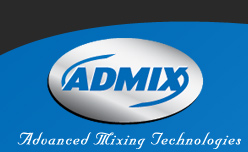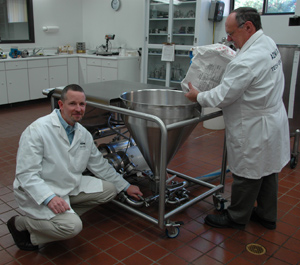
Mixing Tips
Part of our philosophy at Admix is to share our knowledge with all our customers. It’s part of our commitment to ensuring your success. To that end, please take advantage of the following short cuts to some mixing tips that will help you save time and money. As always, call us anytime to discuss your particular circumstances and needs at 800.466.2369.
 Let Admix be Your Mixing Technology Partner!
Let Admix be Your Mixing Technology Partner!
This chart outlines some of the typical ingredients and mixing challenges we have encountered over years of supplying sanitary mixing equipment. Please take a minute to look at the list (click image to open PDF). If you have experienced challenges with any of these and are looking for solutions, contact us at 800.466.2369 or email us at mixing@admix.com.
Admix would like to become your Mixing Technology Partner as we continue to share our expertise with customers worldwide.
Mixer Placement
Bridge-mounted Mixers:
Cylindrical Tanks
-
Baffled: Place mixer dead center.
-
Unbaffled: Place mixer 1/6 to 1/4 tank diameter off center.
-
1/6th will provide strong vortex
-
1/4 will provide very little vortex
-
-
Square or Rectangle Tanks:
-
Baffled or Unbaffled: Place mixer dead center.
-
-
Unsure? Contact Admix at 800.466.2369.
Clamp-mounted mixers: Typically limited to small portable mixers, clamp-mounts are usually on the side wall of the tank or a separate bracket attached to the tank or mixing vessel. General shaft position is at a 10 to 15 degree angle (from a side view, vertical position) into the tank. Also, for swivel-type clamps, the option is to angle the shaft at a 10 to 20 degree angle to the right, as viewed from the top looking down into the mixing tank.
Location of Mixing Head
High Shear Mixing
-
Optimal: One (1) mixing head diameter off bottom
-
1.5 to 2 mixing head diameters minimum coverage
Low Speed Agitation
-
As close as ½ impeller diameter off bottom
-
1.5 to 2 mixing head diameters minimum coverage
Size of Impeller or Mixing Head
High Shear Mixing
-
Ratio of mixing head diameter (D) to tank diameter (T) should be 1/10th or greater.
Low Speed Agitation
-
Ratio of impeller diameter to mixing tank diameter should be 0.25 or better depending upon viscosity. High viscosity requires a minimum 0.35 - 0.4 ratio.
Adding Gums, Hydrocolloids, Powders or Thickeners
 For these powders, conventional "sprinkling" into the tank while mixing is actually detrimental; the viscosity builds slowly and the pumpability of the medium decreases. In high shear/high flow applications, the powder needs to be incorporated and hydrated quickly, before it gets a chance to build viscosity.
For these powders, conventional "sprinkling" into the tank while mixing is actually detrimental; the viscosity builds slowly and the pumpability of the medium decreases. In high shear/high flow applications, the powder needs to be incorporated and hydrated quickly, before it gets a chance to build viscosity.
1. Make sure there is a good vortex and high bulk fluid velocity in tank with the liquid phase
2. Add powder quickly, all at once!
3. You will see that the powder will be incorporated, dispersed, or hydrated more easily.
Mixing Terms
Mixing is a key operation for many processes -- a necessity when two or more ingredients must be blended together. We are often asked to provide a definition of mixing versus agitation or blending. Sounds simple enough, but not so when you add other "mixing" terms such as dispersing, hydrating, suspending or emulsifying! In other words, depending upon the ingredients involved, "mixing" or "blending" may not properly describe the operation required. The following are brief descriptions to define each situation:
Mixing:
The generic term for the operation encompassing all the variations that follow.
Agitating:
Typically defined as a low speed blending operation with turbine type blades or paddles.
Blending:
Mixing or agitating two or more miscible liquids of similar viscosity (or solids only) and density, often done inside a vertical helical screw blender.
Dissolving:
Where the dissolution of a solid in a liquid is necessary, as with salt or sugar solutions. Simple agitation techniques are normally sufficient if time is not a factor, although high shear techniques are required when other solids (ingredients) may block dissolution of the primary solid or when faster dissolution would be beneficial.
Dispersing:
The action of scattering immiscible particles, droplets or gas bubbles in a matrix liquid. The results can properly be called dispersions, but more often they are given more specific names:
-
Suspension, when solid particles, usually above colloidal size, are dispersed
-
Emulsion, when droplets are dispersed, such as oil in water or water in oil
-
Lyosol, when air or gas bubbles are dispersed
Homogenizing:
This term is usually applied to a very intense mixing action, but literally it only means that all components are so thoroughly mixed that they are "made alike". This term should not be limited to the action of one particular type of equipment.
Hydrating:
Many ingredients when used as binding or stabilizing agents will "swell" when activated by high shear and attach themselves to other molecules. Hydrocolloids such as gums, stabilizers, polymers, etc., require a high shear device to be thoroughly dispersed for 100% hydration.
More than Mixing - Size Reduction:
In order to speed up the mixing process, modern machines introduce a high degree of kinetic energy. This very often results in a reduction of particle or droplet size. This can mean
-
the break-up of agglomerations, and can be done in batch or in-line mode, or
-
more typical is the shear action of tearing droplets apart or the crushing or slicing of solid particles.
If any of these mixing operations fit your requirements, or if you have been struggling with a low speed agitator where high shear equipment may be more appropriate, call us toll free at 800.466.2369 for more information about our sanitary mixing equipment specifically engineered for difficult-to-process ingredients.